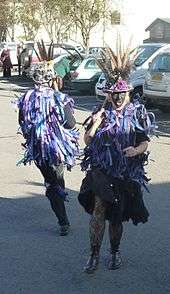Border Morris
Border Morris is a collection of individual local dances from villages along the English side of the Wales–England border in the counties of Herefordshire, Worcestershire and Shropshire. They are part of the Morris dance tradition.
History
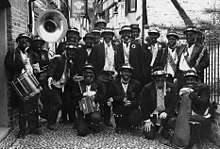
This was a village dance done in winter for fun and a bit of money. It usually includes three to twelve dancers.
Some of the earliest accounts of a border morris tradition are provided by E.C. Cawte.[1] There is reference to questions about "any disguised persons, as morice dancers, maskers, or mum'ers" to St. Mary's Parish Church in Shrewsbury in 1584 and an amazing account of morris dancers at Hereford races in 1609, describing "two musicians, four whifflers, and twelve dancers, including hobby horse and maid marian", all from villages within 14 miles of Hereford. The account claimed, "Hereford-shire for a morris-daunce puts downe, not onely all Kent, but verie neare (if one had line enough to measure it) three quarters of Christendome".
Cawte quotes further accounts describing complaints to the local magistrates about disruptive morris dancers in Longdon, disrupting the Sabbath day from 1614 to 1617 and another account of dancers in Much Wenlock in 1652, causing a disturbance in an ale house at Nordley. Later records from Shrewsbury mention payment to the "Bedlam Morris" in 1688 and 1689.
The dance depends on the numbers available, as at Brimfield. The dances collected from a particular place sometimes differ quite markedly between informants, as at White Ladies Aston, reflecting the flexibility from year to year. Sometimes a gang would only have one dance, sometimes two, or as at Malvern and Pershore an indeterminate set of figures.
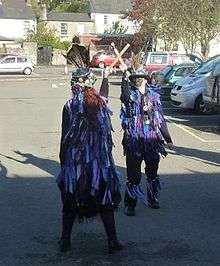
The common features are the rather short sticks and sometimes a stick and handkerchief version of the same dance, also usually a high single step akin to the local country dance step. Such detail as starting foot rules and phrase endings are notable for their apparent absence.
Some of these village sides blackened their faces . There is no record of any sides dancing together. A few – both Upton-upon-Severn dances for example – matched the complexity of Cotswolds Morris, but many – e.g. Bromsberrow Heath – had a stark simplicity of one figure and one chorus repeated forever.[2]
Revival
In the 1960s, E.C. Cawte, the folklorist, proposed that these dances from the English side of the Welsh borders – Herefordshire, Shropshire and Worcestershire – constituted a Welsh border tradition.[3]
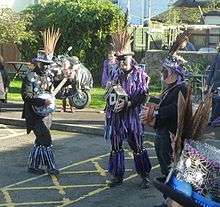
Since the 1960s and with further collecting in the 1970s by people such as Dave Jones (late of Silurian Morris, founded 1969, and later the Not For Joes)[4] and Keith Francis (of Silurian Morris) a distinctive border morris style has grown. The tradition is characterised by black faces, tattered shirts or coats, lots of stick-clashing and a big band traditionally comprising melodeons, fiddles, concertinas, triangles and tambourines, although they now often also feature a tuba or sousaphone, and flute or oboe.
Under the guidance of Dave Jones and Keith Francis, Silurian Border Morris sought to interpret the collected dance material, preserving as much of the traditional styles and features as can be deduced. By contrast, in 1975, John Kirkpatrick created a new border tradition with the Shropshire Bedlams, which seeks to capture the spirit of the border sides, but not recreate any specific tradition or dance. Their dances feature much "whooping" and this has become characteristic amongst many other border sides. Perhaps in keeping with the original tradition, the Original Welsh Border Morris (founded 1973) meet only once a year, at Christmas, and dance the traditional dances of Herefordshire and Worcestershire. With many of the newer sides, the dances have often become complex, involving many invented and evolved steps, figures and choruses.
Many dances were collected by Cecil Sharp and later collectors, and several were included in Bacon's book,[5] but border morris was largely neglected by revival morris sides until late in the 20th century. The Silurian Morris Men of Ledbury, Herefordshire, included border dances in performances from the early 1970s and changed exclusively to border morris in 1979,[6] and the Shropshire Bedlams were founded in 1975;[7] both became pioneers of a resurgence of border morris among revival sides in the following decades.

The Leominster Morris[8] were reformed in 1988, split from The Breinton Morris (who disbanded after a further 10 years) and made contact with one of the musicians from the previous side from the 1930s, Tom Postons. His recollections of the dancing of the time as having "lots of bowing, hat-raising, and clashing of sticks on the ground" led to the "revival" of Postons' stick dance. Cecil Sharp visited the town on 27 December 1909 with local folklorist Ella Mary Leather, and collected tunes from the prolific local gypsy fiddler John Locke. The Leominster men use several of Locke's tunes in their repertoire today.
Border morris dancing was different on the Welsh side of the border, and a team on the Welsh side was formed in 1992. Initially the side was named Morys ar y Clwt but it was changed to Carreg-las in 1997. They use traditional Welsh and English folk and morris dance tunes. Carreg-las translates from the Welsh as 'bluestone', a rock found locally in the Preseli Mountains, of which it is said Stonehenge was constructed.
Theories of origins of blackface
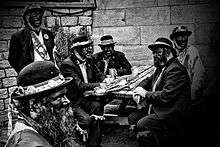
The origins of the blackface are much debated and remain unclear. However, various theories exist, and these are discussed below.
15th-century Moorish mimicry
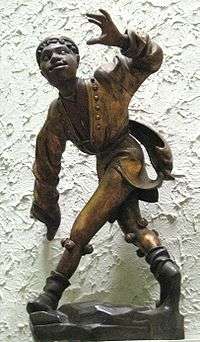
The term morris is believed to be from the late Middle English word morys, a variant of the word moorish[9] – from the Moors of Morocco; this explanation was cited as early as 1801.[10]
Carved figures[11] from 1480 in Munich, Germany, show "Moriskentänzer" with bells, including one of the ten extant having African features. Later evidence from France includes this quote from Thoinot Arbeau circa 1580: "In fashionable society when I was young, a small boy, his face daubed with black and his forehead swathed in a white or yellow handkerchief, would make an appearance after supper. He wore leggings covered with little bells and performed a morris".[12] However, the precise linkage between the morris in France and England at that time remains unclear. Henry VII may have become familiar with French morris during his time in France, and is recorded as having morris at his own court in England (see below).
Another theory is that the blackface tradition derives from earlier forms of the dance involving a Moroccan king and his followers. There is recorded evidence from 1688 of payments in Shrewsbury of 10 shillings to "Ye Bedlam Morris" and 2 shillings for "Ye King of Morocco".[13]
Evidence of the 18th-century association of black faces with morris is given by the description of the Betley Window (a stained-glass window in Betley Hall, Staffordshire, from around 1621, depicting morris dancers) by its owner, George Tollet (1725–1779). Writing in 1778, he states "we are authorised ... to call some of the representations on my window, Morris Dancers, though I am uncertain whether it exhibits one Moorish personage, as none of them have black or tawny faces, nor do they brandish swords or staves in their hands, nor are they, in their shirts adorned with ribbons."[14]
Gallop (1934)[15] questions the Moorish link, quoting both Douce and Cecil Sharp who felt the English dance was too dissimilar in style and appearance to be derived from the continental European Moorish dances believed to be of Moorish origin. Sharp himself appears to have changed his view between 1906, when he saw a link between the black faces of English morris and the dancers on the Franco–Spanish border, and 1912, when he viewed the dance to be a pan-European custom possibly corrupted by Moorish influence. He argued that the name Moorish was used as a description of an existing earlier tradition, not because the dancers represented Moors. Gallop goes on to examine the linkage between the English morris dance and the mouriscada or morisca dances of Spain and Portugal, which involve ritual, choreographed battles between the Christians and Moors or Turks, often to music, involving swords and handkerchiefs. Gallop asks whether the Christian–Moorish link is actually a later interpretation of earlier pagan mock battles between Summer and Winter, such as that fought on May Day on the Isle of Man between the Queens of Summer and Winter. He argues that in parts of Portugal and the Basque Country, the word moor is also used to mean 'pagan', and that perhaps morris dance originally meant 'pagan dance', and that bells and disguised faces are a common feature of pagan ritual. Thus, for Gallop, the Moorish link is coincidental and the true origins are much older and pagan. This view remains popular for many today.
Disguise
Blackface and disguise, often in a pagan themed context have their own history which intersects with morris tradition. There is evidence from the 1450s onward of the blackening of faces with charcoal as a means to evade identification, and in association with pagan themes. In the Kent and Essex enclosure riots of 1450–51 men cross-dressed as 'Queen of the Fairies'[16] (similar to the related Doamna Zînelor, of the Călușari) including those wearing blackface.
An event which took place in the autumn of 1450 illustrates well the way in which the often separate activities of poaching and protest could on occasion conflate. On October 1450 a large group of men entered the duke of Buckingham's park at Penshurst in Kent and carried off eighty-two deer. Thirty-two men, nineteen of them yeomen, were named in subsequent indictment which made clear that a good number had escaped by its claim that there had been a total of a hundred present (not a figure to be taken too literally). These armed men had charcoaled faces, wore long false beards and withheld their names, calling themselves servants of the Queen of the Fairies.[17]
The Rebels' Proclamation of 1489 following on the Black Act a few years prior, provides another contemporary example of disguise in British folk tradition.
In a letter of May 1489 to his brother John Paston III, William Paston III included a copy of the proclamation issued by the rebels shortly after the murder of the earl of Northumberland. Addressing the 'Northe partys of England', this proclamation summoned 'euery lorde, knyght, esquyer, gentylman, and yeman' to array themselves 'for to geynsstonde suche persons as is abowtward for to dystroy owre suffereyn lorde the Kynge and the Comowns of Engelond for suche vnlawfull poyntys as Synt Thomas of Cauntyrbery dyed for'. Becket could have been invoked because of his reputed championing of the interests of the poor, or because of his defence of ecclesiastical privileges. Such interpretations assume that 'vnlawfull' was a hostile interpolation made by William of Paston or his source, yet Becket's martyrdom was universally admired: a more conventional invocation of Becket during the protests in Kent in 1496 paired him with St George. Moreover, the proclamation was issued in the name of a local hobgoblin, 'Mayster Hobbe Hyrste,[18] Robyn God-felaws brodyr'. Protesters adopted such fictive personas not only to conceal identity but also perhaps to associate their grievances with Everyman and to invoke a popular culture of misrule. Elsewhere we find a 'queen of the fairies' leading a rising and her 'servants' poaching; indeed, the first 'black act' against poaching when disguised passed in 1486.[19]
Barbara Lowe's (1957) review of early records of the morris in England[20] cites one of the earliest recorded mentions of the morris in England, with Henry VII paying "Master Wentworth £6 13s. 4d. 'towards the making of a disguising for a morysse'" in September 1501. She goes on to describe later accounts of Henry VIII's Shrovetide banquet for ambassadors in 1509, in which the torchbearers "were appareyled in crymosen satyne and grene lyke Moreskoes, their faces blacke". The following year, in 1510, "there was a Pageant like a mountain, out of which came a Lady of Gold, and the children of honour called the Henchemen, which were freshly disguysed, and danced a Morice before the Kyng".
Lowe (1957) also quotes from The Booke of all maner of Orders concerning an Erles House, dating from around 1510, which provides rules for "plays, interludes and disguisings, including Morrises" and states, "If a Morris is to be performed, it should take place after the disguising". Thus the link to blackened faces, and between morris dance and disguise, is clearly established by the early 16th century, although the nature of that disguise is broader than simply a black face, and includes all manner of elaborate costumes.
E. C. Cawte's (1963) work on morris dancing in Herefordshire, Shropshire and Worcestershire[3] quotes A History of Shrewsbury[21] regarding the Visitation at St. Mary's Parish Church, Shrewsbury, in 1584, when it was asked, "Whether there have bene any lords of mysrule, or somer lords and ladies, or any disguised persons, as morice dancers, maskers or mumm'ers, or such lyke, within the parishe, ether in the nativititide or in som'er, or at any other tyme, and what be their names?" It is thus clear that in Shrewsbury, on the Welsh border, morris dancers were associated with disguise in the 16th century.
The explanation of disguise is also given for the blackface in the later periods, and that during the hard winters of the 17th and 18th century, out of work labourers and builders sought to anonymously supplement their income by a bit of dancing and begging. The use of blackface as a form of disguise is established in early 18th-century England. In 1723 it became a capital offence under the Waltham "Black Act" to appear "in disguise, either by mask or by blackened face". Certainly by the 17th century, border morris seems to have degenerated into a source of public nuisance, as many of Lowe's (1957)[20] primary accounts recall.
19th-century minstrelsy
Chloe Metcalfe (2013)[22] and Richard Carlin (2008) question the link between the American minstrel shows into Victorian England in the late 1830s and the morris.[23] By the early 20th century, border morris dancing was referred to colloquially by some as "nigger dancing" or "going niggering".[24][25] Some view this as direct evidence of the link with minstrel shows.[26]
Theresa Buckland's (1990) research details the linkages between the 19th-century Lancashire Britannia Coconut Dancers and minstrel shows, although it does not discuss any link to Welsh border morris. She argued, "The 'disguise' function of the costume has most likely been influences by Cecil Sharp's [1911] interpretation of the black face [...] which has been repeated in various publications and ephemera of the English Folk Dance and Song Society ... The dancers have been exposed to information from these publications, whether first-hand or further removed." The argument of disguise is used to "explain away" the blackface, while the black faces of dancers have radically different symbolic potential than that of the faces of supposedly disguised labourers.[27]
According to the American Morris News (2005), "It is most commonly thought that the origin and function of blackface in Morris dancing lies in primitive disguise rather than an imitation of black men. However, this is not definitely the case. Accounts of the Morris of Shakespeare's time make no mention of blackface, while the border teams contemporary with minstrel shows typically blacked up. American minstrel shows, if not the actual origin of blackface among Morris dancers, at least contributed to its popularity."[26]
Robert Hornback (2008) has a different viewpoint, comparing border morris to crude parodies of African tribal war dances, and cites the blackface of Morris dancing as part of racist practices in Britain that predate American minstrelsy and, in fact, contribute to the minstrel tradition.[28]
Modern interpretations
Canadian academic Pauline Greenhill, commenting on morris dancing in Canada, writes that
[...] it seems unlikely that North American audiences, who encounter Morris at dance-outs at local shopping centres, pubs, and so on, far from geographical associations with coal miners, would see in blackface dances anything other than a white peoples' representation of black culture. Unfamiliar with the localised and historicised explanations of Morris tradition used by dancers, audiences might historically contextualise blackface in terms of entertainment forms such as vaudeville and view it in light of the overtly or covertly racist ideas associated with these practices. Or they might locate it in a slightly more up-to-date scenario of riots and gangs.[29]
In an ethnographic study of Morris dancing, Greenhill states that the blackface practices of other English dances "only underscores the colonial complicity of Morris, particularly for non-English, nonwhite audiences." [30]
It is possible that the interpretation of the blackface changed over the centuries – from Moroccan mimicry, to disguise, to a minstrel-inspired costume and back to disguise. To avoid controversy, some modern sides wear masks or colour their faces in different colours.
Changing times
Regardless of the historical basis for black face disguise in border morris, the practice has become increasingly controversial. Although initially confined to specific folk events or newspaper articles, the issue was brought into focus by the rapidly changed social awareness following the George Floyd Protests and growing international impact of the Black Lives Matter movement. This led to the Morris Ring issuing a statement on 3 July 2020 [31]
During the current lockdown and suspension of morris activity, the Black Lives Matter protests and more significantly counter protests by far right groups have brought a decisive shift in how issues such as this are viewed and debated in public life.
The use of full black or skin tone face make up has become part of a range of symbols used in political campaigning. Most worrying of all to the officers is that justifications for using it based on culture/tradition have been appropriated by the political far right. The fact that some feel the practice to be racist should be enough for sides to realise it is no longer acceptable and is wrong when viable alternatives clearly exist.
Those that wish to continue are now consciously taking morris into a political debate. The Morris Ring is an apolitical organisation and such sides who do not change must continue that debate outside of membership of the Morris Ring. As an organisation, we are open to clubs to join who agree to uphold the standards and dignity of Morris. The officers unanimously agree that the use of such face make up now falls short of this test and is wrong. They advise member sides who wish to remain in the Morris Ring to stop this practice.
This was in part motivated by an opinion piece written by the UK far-right organisation Patriotic Alternative on 1 July 2020, encouraging their followers to take up Morris Dancing (of all kinds, not specifically Border Morris) [32] and rejected in a statement the following day by the Joint Morris Organisation[33].
On 3 July 2020, the Joint Morris Organisation, representing the Morris Federation, the Morris Ring and Open Morris, issued a press statement to The Telegraph[34] newspaper in the UK, stating,
Our traditions do not operate in a vacuum. While no morris dancer wants to cause offence, we must recognise that full face black or other skin tone makeup is a practice that has the potential to cause deep hurt.
Morris is a living tradition and it is right that it has always adapted and evolved to reflect society. Over the past few years, many morris teams have already proactively taken the decision to stop using full face black makeup to avoid causing offence or hurt. We now believe we must take further steps to ensure the continued relevance and inclusivity of the tradition.
The Joint Morris Organisations (The Morris Federation, The Morris Ring, and Open Morris) have therefore agreed that each of them will take action to eliminate this practice from their membership. Teams that continue to use full face black or other skin tone make up will find they are no longer part of the mainstream morris community, be covered by JMO public liability insurance, or invited to take part in events organised or sponsored by the JMO.
Morris is a unique cultural tradition of which we should be rightly proud. We want people from all races and backgrounds to share in this pride and not be made to feel unwelcome or uncomfortable by any element of a performance.
References
- Cawte, E.C. (1963). "The Morris Dance in Herefordshire, Shropshire and Worcestershire". Journal of the English Folk Dance and Song Society. 9 (4): 197–212. JSTOR 4521671.CS1 maint: ref=harv (link)
- Details of the collected dances can be found in Roy Dommett's Source Material for the Border Morris Tradition
- Cawte 1963.
- Jones, Dave (1988). The Roots of Welsh Border Morris. Putley, Herefordshire: Annie Jones. ISBN 0 9526285 0 3.
- Bacon, Lionel 1974 A Handbook of Morris Dances. Published by The Morris Ring
- "History". Silurian Border Morris Men. Archived from the original on 2013-11-03. Retrieved 2006-10-11.
- Kirkpatrick, John (1979). "Bordering On the Insane". English Dance and Song. 41 (3): 12–14.
- "About us". Leominster Morris.
- "Definition of Morris Dance".
- Strutt, Joseph (1801). The Sports and Pastimes of the People of England. London: Methuen & Co.
- "Die Moriskentänzer- Dauerausstellung". Stadtmuseum-online.de. Retrieved 18 December 2011.
- "Orchésographie (Arbeau, Thoinot)". Retrieved 1 March 2013.
- Ashman, Gordon (April 2005). "Border Morris: Roots & Revival (Transcript of Talk)". American Morris Newsletter. Retrieved 18 December 2011.
- Nicol, E.J. (1953). "Some Notes on the History of the Betley Window". Journal of the English Folk Dance and Song Society. 7 (2).
- Gallop, Rodney (1934). "The Origins of the Morris Dance". Journal of the English Folk and Dance Society. 1 (3): 122–129.
- Normington, Katie (2004). Gender and Medieval Drama. Drama. Boydell & Brewer, Incorporated. ISBN 9781843840275.
- Aston, Trevor Henry (2004). Evans, T. A. Ralph (ed.). Lordship and Learning: Studies in Memory of Trevor Aston. History, Europe, Great Britain. Boydell & Brewer, Incorporated. doi:10.1604/9781843830795. ISBN 9781843830795.
- hurst (n.) "hillock" (especially a sandy one), also "grove, wooded eminence," from Old English hyrst "hillock, wooded eminence," from Proto-Germanic *hursti- (see horst). Common in place names (such as Amherst).
horst (n.) 1893 in geology, from German Horst "mass, heap" (given its geological sense by Suess, 1883), from Old High German hurst "thicket," from Proto-Germanic *hursti-, from PIE *krsti- (source also of Middle Dutch horst "underwood," Old English hyrst "grove, wooded eminence"), from root *kert- "to turn, entwine" (see hurdle (n.)).
see: http://etymonline.com/...hyrst - Cavill, P. R. (2009). The English Parliaments of Henry VII 1485-1504. Oxford Historical Monographs. OUP Oxford. doi:10.1093/acprof:oso/9780199573837.001.0001. ISBN 9780191610264.
- Lowe, Barbara (1957). "Early Records of the Morris in England". Journal of the English Folk and Dance Society. 8 (2): 61–82.
- Owen, H.; Blakeway, J. B. (1825). A History of Shrewsbury. London: Harding, Lepard and Co.
- Metcalfe, Chloe (December 2013). "To Black Up or Not to Black Up?". The Morris Federation. Retrieved 15 October 2014.
- Carlin, Richard (4 August 2008). "Morris Dancers or Minstrel Show?". Richard's Music and More. Retrieved 18 December 2011.
- "The Collected Border Morris". Opread.force9.co.uk. Retrieved 18 December 2011.
- "Visit to Herefordshire & Worcestershire, May 1957". Dspace.dial.pipex.com. Archived from the original on 4 February 2012. Retrieved 18 December 2011.
- Krause, Rhett (December 2005). "Morris Dancing And America Prior to 1913". American Morris Newsletter. Retrieved 18 December 2011.
- Buckland, Theresa Jill (1990). "Black Faces, Garlands, and Coconuts: Exotic Dances on Street and Stage". Dance Research Journal. Congress on Research on Dance. 22 (2): 1–12. JSTOR 1477779.
- Hornback, R. (2008). ""Extravagant and Wheeling Strangers": Early Blackface Dancing Fools, Racial Impersonation, and the Limits of Identification". Exemplaria. 20 (2): 197–222. doi:10.1179/175330708X311353.
- "On the Whiteness of Morris: An Illumination of Canadian Folklore" (PDF).
- Greenhill, Pauline (2002). "Folk and Academic Racism: Concepts from Morris and Folklore". Journal of American Folklore. American Folklore Society. 115 (456): 226–246. doi:10.2307/4129221. JSTOR 4129221.
- "Statement from the Morris Ring Officers Re: The Use of Full Black or Skin Tone Face Make Up By Morris Ring Member Sides | The Morris Ring". themorrisring.org. Retrieved 4 July 2020.
- "Morris Dancing: An Appeal to Young Nationalists". www.patriotalternative.org.uk. Retrieved 4 July 2020.
- "Joint Morris Organisation condemns nationalist website article". Retrieved 4 July 2020.
- Simpson, Craig (3 July 2020). "Morris dancing groups ban blackening faces". The Telegraph. Retrieved 4 July 2020.
External links
| Wikimedia Commons has media related to Border Morris. |
- https://www.academia.edu/5468139/To_Black_up_Or_Not_to_Black_Up_A_Personal_Journey
- http://www.great-western.org.uk/dommett/BlackFace.pdf
- https://web.archive.org/web/20120222000637/http://www.ironmenandseverngilders.org/
- Border Morris: Roots & Revival, Gordon Ashman
- Visit to Herefordshire and Worcestershire, May 1957. E.C. Cawte
- History of Border Morris
- Breinton Morris's take on Border Morris
- The Pershore Morris (pdf)
- German carvings from 1480 showing "moriscan dancers" including black faces
- Home page of the Silurian Border Morrismen
- Mike Miller's Border Morris Notes
- Mythago Morris Home page
- Samples of the border sound
- Styx of Stroud Border Morris home page
- Vancouver Morris Men Winter Dances page
- Steeleye Span - A Mummers Play (circa 1400)
